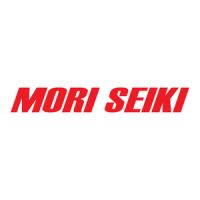P-11FOR SAFE MACHINE OPERATION PARA UNA UTILIZACIÓN SEGURA DE LA MÁQUINA
7-3 When Chucking Workpiece
Durante el agarre de la pieza
ATENCION
<Setting>
1. Refer to the instruction manuals prepared
by the chuck and cylinder manufacturers
for the allowable plunger thrust of the
chuck, allowable chucking and cylinder
pressures, and the relationship between the
top jaw height and allowable cylinder
thrust, which must be set to a value within
the permissible value range. If difficult to
determine, contact the Mori Seiki Service
Department.
[Chuck, cylinder damage/Workpiece and
jaw ejection]
2. Set the chucking pressure and tailstock
spindle thrusting force (tailstock specifica-
tions only) with full consideration given to
the shape and material of the workpiece to
be machined and machining conditions.
[Workpiece ejection]
3. The user is responsible for setting the
speed of the chuck by taking the workpiece
dimensions and shapes, cutting force, and
chuck maintenance and inspections into
consideration. Rotate the spindle at a
speed no faster than allowable values
under specified conditions.
[Workpiece ejection]
<Soft Jaws>
Do not machine the counter bore depth of the
soft jaw mounting bolt.
[Loosened soft jaw causing workpiece ejection]
<Lifting Workpiece>
1. Only technicians qualified to operate
cranes are to perform workpiece-lifting
procedures.
[Workpiece, Machine damage/Accident]
2. When two or more people are involved in
lifting, cooperation and clear communica-
tion is necessary at all times.
[Accident]
3. Use only wires, shackles and jigs strong
enough to support the total weight of the
workpiece.
[Dropped workpiece]
4. Before lifting a workpiece, check that is
held securely.
[Workpiece ejection]
5. Raise the workpiece a short distance off the
floor to confirm it is well balanced in both
crosswise and lengthwise directions.
[Dropped workpiece]
<Configuración>
1. Consulte los manuales de instrucciones
suministrados por los fabricantes del plato y del
cilindro para comprobar el empuje permitido del
pistón del plato, y las presiones permitidas de
agarre y del cilindro, así como la relación entre la
altura de la mordaza superior y el empuje permitido
del cilindro, los cuales deberán configurarse con un
valor dentro del intervalo permitido. Si resulta difícil
de determinar, póngase en contacto con el servicio
de asistencia de Mori Seiki.
[Daños al plato o cilindro/Eyección de pieza y
mordaza]
2. Configure la presión de agarre y la fuerza de empuje
del husillo en el contrapunto (solamente
especificaciones de contrapunto) teniendo
totalmente en consideración la forma y el material
de la pieza que se mecanizará y las condiciones de
mecanizado.
[Eyección de pieza]
3. El usuario será responsable de configurar la
velocidad del plato teniendo en cuenta la forma y
dimensión de la pieza, la fuerza cortante y las
inspecciones y mantenimiento del plato. Gire el
husillo a una velocidad que no sea mayor que los
valores permitidos según las condiciones
especificadas.
[Eyección de pieza]
<Mordazas blandas>
No mecanice la profundidad de avellanado del perno de
montaje de la mordaza blanda.
[Aflojamiento de la mordaza blanda, lo cual causa la
eyección de la pieza]
<Elevación de pieza>
1. Los procedimientos de elevación de piezas única-
mente deberán ser realizados por personal cualifi-
cado para utilizar grúas.
[Daños a la máquina, pieza/Accidente]
2. Cuando dos o más personas participan en el trabajo
de elevación, deben cooperar y comunicarse de
forma clara en todo momento.
[Accidente]
3. Utilice exclusivamente cables, abrazaderas y
plantillas lo suficientemente resistentes como para
soportar el peso total de la pieza.
[Desprendimiento de pieza]
4. Antes de levantar una pieza, compruebe que esté
bien sujeta.
[Eyección de pieza]
5. Levante la pieza una distancia corta del suelo para
confirmar que esté bien colocada en dirección
transversal y longitudinal.
[Desprendimiento de pieza]

